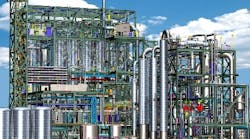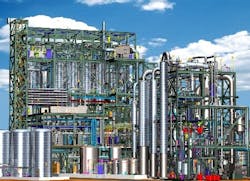A year that raised the public’s awareness of oil price trends, global warming, and other environmental sustainability issues also may prove to have been a turning point for the chemical industry. In 2005, the outlines of a substantially different industry, shifting gradually from petroleum-based feedstocks to renewable resources, gained clarity amid talk of a new generation of biorefineries and other initiatives involving new products, processes and partnerships.
Some of the news was about progress that already has been made by companies and consortia which, often with help from U.S. government grants, are exploring new pathways from plants, crop oils, and biomass waste to basic building blocks, chemical intermediates and fuels. Much of the buzz came from executives’ ambitious projections about the potential technological leaps, although there were also reminders that economic hurdles could slow change.
Growing momentum
DuPont, Wilmington, Del., was a leader in last year’s consciousness-raising. In a November briefing, Thomas M. Connelly, chief science and technology officer, pledged a 30% acceleration in science-based innovation, and cited bio-based materials as “the right science at the right time.” Components of DuPont’s bio-based materials pipeline have an estimated net present value exceeding $3 billion, he said.
The company has a joint venture with Tate & Lyle to build a $100-million plant at Loudon, Tenn., that will use corn to produce 1,3 propanediol (PDO) (see CP, October, p. 11). This building block, which DuPont has trademarked Bio-PDO, is a key ingredient in its Sorona polymer. The plant (Figure 1) is expected to start up in mid-2006. DuPont also said in November that it would invest $55 million to expand its Sorona plant at Lenoir County, N.C.
The biorefinery
“I like to think of this as very similar to an oil refinery, taking a very crude material, breaking it down into its smallest components and then making multiple business products out of it,” says Patrick McCroskey, Diversa’s vice president of business development.
Many facilities are already described as biorefineries, but this “integrated biorefinery” is different because it represents integration on so many different levels, McCroskey says. It requires the combination of biological, chemical and other expertise. It envisions multiple inflows of feedstocks and multiple outputs of fuels and other products. It recognizes the need to match modified cocktails of high-performing enzymes with different feedstocks and fermentation suited to different products. Perhaps most importantly, it recognizes the need to combine technologies in a way that meets business imperatives.
Conversion of lignocellulosic biomass into its component sugars is already technically feasible, says Mark Burk, Diversa’s senior vice president of chemical and industrial R&D. But the cost of conversion is too high, especially when one of the outputs is relatively low-cost ethanol. “It’s going to take a step change in the activity of the enzymes in order to get to where we need to be for economic viability.”
For Diversa, which also has biotech collaborations with other chemical companies including Syngenta, DSM, Cargill, and BASF, bio-based products have become a focus area, says McCroskey. But the speed with which the DuPont consortium has progressed should not imply that the path ahead is easy, he cautions, adding that government funding — which has averaged $100 million to $300 million annually for bio-based research in recent years — will still be necessary perhaps for a decade.
Chemical companies will face their own challenges, including the “dramatically different” processing that may be needed when a fermentation paradigm replaces a continuous production paradigm, McCroskey says. One key to success will be continued smart partnering between chemical companies and enzyme makers, so that the right, cost-effective technologies are developed in tandem. He is optimistic about the success of the DuPont-led consortium: “We may not be the first biorefinery, but we’ll be the first one that can make money.”
Other drivers
The profit motive, coupled with the desire to reduce reliance on oil with its growing price and supply uncertainties, is certainly important to the future of bio-based chemistry, but it’s not the only driver. Companies also are attracted to the trio of economic, social, and environmental benefits.
BIO, the Biotechnolgy Industry Organization, Washington, D.C., notes that the benefits could include: new consumer products; new markets for the agricultural sector; the possibility of smaller, regional processing facilities around the country and around the world; energy savings; and reduced carbon dioxide emissions. A wide array of companies apparently find this combination appealing. “We’ve had quite a few new members lately” from the chemical sector, says Brent Erickson, vice president for BIO’s industrial and environmental section.
Carbon dioxide reductions will be especially attractive if woody biomass becomes an important feedstock, notes David Shonnard, a chemical engineering professor at Michigan Technical University, Houghton, Mich., and co-author of the book “Green Engineering: Environmentally Conscious Design of Chemical Processes.” Today’s reliance on fossil fuels, he says, acts “like a giant carbon pump working on a global scale,” bringing carbon from beneath the ground and sending it into the air, but the multiplication of plants and trees as feedstocks would “close the loop on carbon,” because such processes embrace the power of photosynthesis to remove carbon dioxide from the air while sending less of it back.
But Shonnard acknowledges several challenges that must be overcome. Wood is naturally resistant to degradation, so the enzymes and microorganisms needed to break it down are of a different order than those for corn kernels or some other renewable resources. The Natural Resources Defense Council, New York, in a 2004 report noted that “large scale penetration of cellulosic biofuels will require growing millions of acres of dedicated energy crops,” so early adoption of bio-based materials will rely more on agricultural and forest residues.
Shonnard also cites the chemical industry’s existing infrastructure as a possible obstacle to progress, partly because “the processes for converting these bio-based raw materials into products are different from the processes for converting fossil fuel materials into products.” Economic judgments justifying the changeover are complicated by the fact that environmental costs being paid by society under today’s fossil fuel regime are not well captured in the calculations watched by investors, he adds.
Different directions
Dow Chemical, Midland, Mich., took several steps assessing the costs and benefits of bio-based materials in 2005. It sold its stake in the Cargill Dow joint venture that produces polylactic acid (PLA) at Blair, Neb., from lactic acid derived from corn. But the company plans to retain bioprocessing in its toolbox, noting it “continues to make significant progress in its development of natural-oil-based polyols that can be used in lieu of a significant percentage of hydrocarbon-based polyols in urethane formulations.” Dow, which began research on such bio-based polyols in 2001, says it started product sampling with select manufacturers of flexible urethane slab in the U.S. and Europe in autumn 2005 and plans to continue the effort at least through this year.
The process for the “new family of vegetable-oil-based polyol products” developed and patented by Dow involves the disassembly of soybean or other natural oil feedstocks using a selective modification of the resultant fatty acids and the reassembly of the molecules into the desired product. “This process offers a number of advantages to both the manufacturer and the end-user,” Dow said in a statement to Chemical Processing. The ability to precisely tailor the degree of conversion of soy esters “allows for on-the-spot adjustment in the production of the bio-based polyols to compensate for the variation in the feedstocks.” The process also produces primary hydroxyl groups, yielding fast-reacting polyols that significantly enhance polyurethane foam’s processibility. Moreover, Dow says, a foam manufacturer can eliminate additional processing steps ordinarily needed to remove olefins — because the new process involves the complete hydrogenation of residual olefins, which helps to remove at their source odor-forming chemistries, which are common in natural-based polyols.
This development of natural oil polyols “is consistent with Dow’s effort to explore options to hydrocarbon-based feedstock challenges and opportunities, as well as supporting a sustainable environment,” Dow said in its statement.
Other initiatives include a production agreement announced early last year between Dow Haltermann Custom Processing and World Energy, Chelsea, Mass., a leading producer of biodiesel fuel.
Meanwhile, Cargill, Minneapolis, Minn., which has a number of active and planned investments and joint ventures for biodiesel and ethanol production in both the U.S. and Europe, has expressed wide-ranging interest in developing bio-based materials for the chemical industry. The company bought the Dow stake in their joint venture for PLA, which it calls the world’s first greenhouse-gas-neutral polymer made from corn. The PLA business, renamed NatureWorks in early 2005, now is focusing on the packaging market and has captured big customers like Wal-Mart, which currently uses NatureWorks PLA in some of its food packaging. Sales last year were projected to be more than 170% ahead of the 2004 level, a spokeswoman said.
Cargill says it made its first commercial sales of bio-based urethane polyols in the summer of 2005. The company also announced earlier last year that it had expanded a development agreement to use the proprietary olefin metathesis technology of catalysts company Materia, Pasadena, Calif. The aim is to convert bio-based oils to industrial chemicals, feedstocks and consumer products. Cargill sums up its bio-based enthusiasm with the estimate that “more than two thirds of the $1.5 trillion global industrial chemicals and plastics business could potentially be served by renewable materials.”
Biodiesel beckons
Another major player in agricultural feedstocks, Archer Daniels Midland, Decatur, Ill., announced plans in October to build its first wholly owned biodiesel production facility in the U.S. The 50-million-gallon plant at Velva, N.D., will use canola oil as its primary input. ADM, already active in the biodiesel market in Europe and a leader in U.S. ethanol production, also revealed in September that it plans to expand ethanol capacity by 500 million gallons.
Ethanol and biodiesel fuel might be among the products from a next generation of biorefineries, but much of the chemical industry’s — and DOE’s — interest is focused on other potential biorefinery products, and how these would become building blocks for plastics or a variety of value-added platforms. ADM, for its part, announced in November a plan to build a polyols facility that will use renewable carbohydrate- or glycerol-based feedstocks. The plant, whose location has not yet been disclosed, will produce propylene glycol and ethylene glycol. The company also is in a strategic alliance with Metabolix, Cambridge, Mass., to commercialize a new generation of high-performance plastics based on renewable resources.
Key criteria
The economic justification for plants based on bio-based feedstocks first and foremost depends upon what the materials bring to the value-added products. Discerning the right mix of operations to achieve profitability at different sites “is both the promise and the danger of designing these plants,” says Chuck McCleskey, Atlanta, Ga.-based leader of the bioprocessing strategic initiative at engineering and construction firm CH2M Hill Lockwood Greene. The configuration must be based on a degree of certainty about what the plant will produce, how many products it will make, and in what volumes, and it must allow for flexibility, he says.
Plant location is also an important factor; proximity to feedstocks might offer sufficient logistical savings to justify construction of a new plant, but at other times the retrofitting of an existing plant might make more sense. Despite these uncertainties, the bio-based sector is “growing every day and gaining momentum,” McCleskey says. “A lot more of these projects are moving forward now,” he stresses.
“We’re looking for opportunities to use bio-based materials where the advantage is either performance or cost competitiveness,” says Tom Kauffman, technical manager of adhesives and sealants at Rohm and Haas, Spring House, Pa. The company is in a partnership with Eastman Chemical, Kingsport, Tenn., and Virginia Tech, Blacksburg, Va., backed by a grant from DOE and the U.S. Department of Agriculture.
Rohm and Haas has met an aggressive timetable to develop prototypes of adhesive components that meet performance requirements, says technology partnerships leader Katie Hunt. Thus it is starting to supply some of the answers to crucial questions such as: What building blocks would chemical companies want to use? Which of the competitive routes to those building blocks would be most economical? What would be the optimal team of organizations to work on the bio-based pathways of the future? It’s crucial for research to proceed simultaneously at both ends of the pipeline before new biorefineries are built, she says. After all, Hunt cautions: “You could make all these building blocks, but what if nobody uses them?”
The company’s monomers group is involved with Engelhard, Iselin, N.J., and the University of Delaware, Newark, Del., in another DOE effort to develop new sustainable catalyst chemistries, seeking “a template for going from alkanes to higher products,” Hunt says. A separate DOE effort has allied the company with ADM and the University of Minnesota, Twin Cities, to pursue sustainable coatings chemistries, using bio-based materials in a new process to generate binders for paints. She calls this initiative, which has been trimmed back because of government budget cuts, an example of the need for continued government support in risky endeavors that have long time horizons. Such funding could have big payoffs because new processing pathways could save “trillions of BTUs” of energy, use less raw materials, and capture maximum performance from building-block chemicals.
Process challenges
In general, companies hope to be able to shift from petroleum-based to bio-based feedstocks with the same manufacturing infrastructure, says Kauffman, but some new pathways may have important differences. “Certain building blocks are inherently more variable” than their petroleum-based predecessors and may be more limited in their utility or reliability, or may require more purification or additional processing steps, even if they have otherwise desirable characteristics, he notes.
The work already done by Rohm and Haas has found “very promising” signs that the pathways developed for adhesives could be applicable to other product platforms, hugely multiplying the volume of chemicals that might become bio-based, says Kauffman. Hunt adds that the possibilities are “compelling.”
Research in all these areas must continue, and has gotten “a good kick” from the 2005 spike in oil prices, says Hunt, although companies like Rohm and Haas were looking at bio-based chemistry before that.
Among the companies that have been working on pieces of the complex puzzle, with assistance from DOE funds, are enzyme companies Genencor International, Palo Alto, Calif., and Novozymes, Bagsvaerd, Denmark. They both reported last year significant reductions in the cost of cellulase enzymes for converting biomass to ethanol, acknowledging that this is just one step toward their increased involvement in biorefining. Genencor announced in 2005 a new enzyme technology that increases energy efficiency and reduces processing steps in ethanol production. Novozymes recently launched three new enzymes that make the production of ethanol from wheat, rye, and barley up to 20% more efficient.
The DOE, for its part, in 2004 issued a “top 12” list of high-potential, value-added building blocks that might be produced from biomass-derived sugars (see sidebar). Among these are four-carbon di-acids such as succinic acid.
DSM, Heerlen, the Netherlands, formed in late 2003 a partnership with Diversified Natural Products (DNP) of East Lansing, Mich., for commercializing succinic-acid-based products derived through fermentation. DNP announced last August a joint venture with Agro-Industrie Recherches et Developpements, Pomacle, France, to produce succinic acid from corn. Also last summer, AgRenew Inc., Manhattan, Kan., began testing the use of grain sorghum as food for bacteria that make succinate, which is a key ingredient in drugs, food additives, solvents and plastics.
BASF, Ludwigshafen, Germany, says its long-range strategy for sustainable development includes “eco-efficiency analysis” of its products, which includes assessing alternative production processes by their consumption of raw materials and energy and generation of emissions.
Other companies, universities, and research institutions have made various announcements about initiatives in bio-based materials. All told, the news of the past year not only suggests a critical mass of interest, funding, and projects, but also powerfully illustrates the depth and breadth of expertise that must come together, from all sorts of organizations, for continuing progress.
The arena of these initiatives is nothing less than a “new frontier,” says Kauffman of Rohm and Haas. “Chemical processing, biotransformation, and enzymatic transformation are all converging to give us a new future chemistry.”
|
The DOE considers the following chemicals, which can be produced from sugars via biological or chemical conversion, particularly promising for making high-value bio-based chemicals or materials: • four carbon 1,4 di-acids (succinic, fumaric, and malic) |



